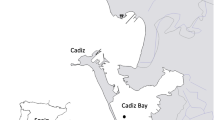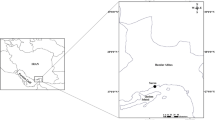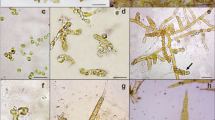Abstract
Laboratory culture of the rhodophyte Gracilaria gracilis (Stackhouse) M. Steentoft, L.M.Irvine & W.F.Farnham which often grows in many stressed Mediterranean coasts, mainly lagoons, was carried out to ascertain the optimum range and interaction of environmental factors on growth and composition with a view to potential mariculture. The methodology adopted was based on the synergy between mathematical modeling and laboratory experiments. An experimental design and a response surface methodology (RSM) were used to simulate field conditions. Experiments were done at 20 °C. The studied responses were daily growth rate (DGR), agar yields, and protein and R-phycoerythrin (RPE) contents. Second-order quadratic polynomial models for all studied responses were deduced and ANOVA showed them to be significant (p < 0.05). The RSM was successfully applied to assess the effects of abiotic factors (light, salinity, ammonium, and nitrate) and their interaction on the DGR, agar yields, and protein content. Gracilaria gracilis grew well (> 3% day−1) under all the combined abiotic factor conditions that were simulated. Hence, the optimum (5% day−1) was obtained around seawater salinity (36 psu), 198 μmol photons m−2 s−1 irradiance and nitrogen concentration of 80 μmol ammonium g−1 fw L−1, and 210 μmol nitrate g−1 fw L−1. Optimum agar yields (15%) were obtained at a lower irradiance (70 μmol photons m−2 s−1) and a salinity of 24 psu combined with similar ammonium (80 μmol g−1 fw L−1) and nitrate (100 μmol g−1 fw L−1) concentrations. Optimum protein contents (23%) and RPE contents (1.2 mg g−1 fw) were obtained at lower irradiance (70 μmol photons m−2 s−1), a salinity of 24 psu, an ammonium concentration of 80 μmol g−1 fw L−1, and lower nitrate concentration (10 μmol g−1 fw L−1). In addition, abiotic factor interaction effects occurred when one of them significantly contributes to response reduction. In conclusion, potential mariculture of G. gracilis in the lagoon is possible but related to their proteins and pigments (essentially RPE) contents in addition to agar yields.






Similar content being viewed by others
References
Abreu MH, Pereira R, Buschmann AH, Sousa-Pinto I, Yarish C (2011) Nitrogen uptake responses of Gracilaria vermiculophylla (Ohmi) Papenfuss under combined and single addition of nitrate and ammonium. J Exp Mar Biol Ecol 407:190–199
Anderson RJ, Levitt GJ, Share A (1996) Experimental investigations for the mariculture of Gracilaria in Saldanha Bay, South Africa. J Appl Phycol 8:421–430
Anderson RJ, Smit AJ, Levitt GJ (1999) Upwelling and fish-factory waste as nitrogen sources for suspended cultivation of Gracilaria gracilis in Saldanha Bay, South Africa. Hydrobiologia 398:455–462
Barufi BJ, Korbee N, Oliveira MC, Figueroa FL (2011) Effects of N supply on the accumulation of photosynthetic pigments and photoprotectors in Gracilaria tenuistipitata (Rhodophyta) cultured under UV radiation. J Appl Phycol 23:457–466
Ben SR, Fethi M, Hatem M, Amine BS, Badii BS, Abderrahman B (2018) Effects of depth and initial fragment weights of Gracilaria gracilis on the growth, agar yield, quality, and biochemical composition. J Appl Phycol 30:2499–2512
Berges JA, Franklin DA, Harrison PJ (2001) Evolution of an artificial seawater medium: improvements in enriched seawater, artificial water over the last two decades. J Phycol 37:1138–1145
Bradford MM (1976) A rapid and sensitive method for the quantification of microgram quantities of protein utilizing the principle of protein-dye binding. Anal Biochem 72:248–254
Bunsom C, Pratheep A (2012) Effects of salinity, light intensity and sediment on growth, pigments, agar production and reproduction in Gracilaria tenuistipitata from Songkhla lagoon in Thailand. Phycol Res 60:169–178
Cano-Europa E, Ortiz-Butrón R, Gallardo-Casas CA, Blas-Valdivia V, Pineda-Reynoso M, Olvera-Ramírez R, Franco-Colin M (2010) Phycobiliproteins from Pseudanabaena tenuis rich in C-phycoerythrin protect against HgCl2− caused oxidative stress and cellular damage in the kidney. J Appl Phycol 22:495–501
Choi HG, Kim YS, Kim JH, Lee SJ, Park EJ, Ryu J, Nam KW (2006) Effects of temperature and salinity on the growth of Gracilaria gracilis and G. chorda, with the potential for mariculture in Korea. J Appl Phycol 18:269–277
Craigie JS, Wen ZC (1984) Effects of temperature and tissue age on gel strength and composition of agar from Gracilaria tikvahiae (Rhodophyceae). Can J Bot 62:1665–1670
Daughtery BK, Bird KT (1988) Salinity and temperature effects on agar production from Gracilaria gracilis strain G-16. Aquaculture 75:105–116
Dawes CJ, Moon RE, Davis MA (1978) Photosynthetic and respiratory rates and tolerances of benthic algae from a mangrove and salt marsh estuary: A comparative study. Estuar Coast Mar Sci 6: 175–185
Dawes CJ, Lluisma AD, Trono CG (1993) Clonal propagation of Eucheuma denticulatum and Kappaphycus alvarezii for Philippine seaweed farms. Hydrobiologia 260:379–383
Dawes CJ, Orduña-Rojas J, Robledo D (1999) Response of the tropical red seaweed Gracilaria cornea to temperature, salinity, and irradiance. J Appl Phycol 10:419–425
D'Elia CF, De Boer JA (1987) Nutritional studies of two red algae. II Kinetics of ammonium and nitrate uptake. J Phycol 14:266–272
Derringer G, Suich R (1980) Simultaneous optimization of several response variables. J Qual Technol 12:214–219
Destombe C, Godin J, Nocher M, Richerd S, Valero M (1993) Differences in response between haploid and diploid isomorphic phases of Gracilaria gracilis (Rhodophyta: Gigartinales) exposed to artificial environmental conditions. Dev Hydrobiol 85:131–137
Ekman P, Pedersen M (1990) The influence of photon irradiance, day length, dark treatment, temperature, and growth rate on the agar composition of Gracilaria sordida W. Nelson and Gracilaria gracilis (Hudson) Papenfuss (Gigartinales, Rhodophyta). Bot Mar 33:483–495
FAO (2015) Mediterranean coastal lagoons: sustainable management and interactions among aquaculture, capture fisheries and the environment. FAO, Rome
FAO (2016) La situation mondiale des pêches et de l’aquaculture 2016. Contribuer à la sécurité alimentaire et à la nutrition de tous Rome, p224
Freile-Pelegrín Y, Robledo D, Pedersén M, Bruno E, Rönnqvist J (2002) Effect of dark and salinity treatment in the yield and quality of agar from Gracilaria cornea (Rhodophyceae). Cienc Mar 28:289–296
Friedlander M (1991) Growth rate, epiphyte biomass and agar yield of Gracilaria conferta in an annual outdoor experiment. 1. Irradiance and nitrogen. Bioresour Technol 38:203–208
Friedlander M, Galai N, Farbstein H (1990) A model of seaweed growth in an outdoor culture in Israel. Hydrobiologia 204:367–373
Friedlander M, Krom MD, Ben-Amotz A (1991) The effect of light and ammonium on growth, epiphytes and chemical constituents of Gracilaria conferta in outdoor cultures. Bot Mar 34:161–166
Goupy J, Creighton L (2007) Introduction to design of experiments with JMP examples, Third edn. SAS publishing
Grossman AR, Schaefer MR, Chiang GG (1993) The phycobilisomes a light-harvesting complexe responsive to environmental conditions. Microbiol Rev 57:725–749
Guiry MD, Cunningham EM (1984) Photoperiodic and temperature responses in the reproduction of north-eastern Atlantic Gigartina acicularis (Rhodophyta: Gigartinales). Phycologia 23:357–367
Hanisak DM (1990) The use of Gracilaria tikvahiae (Gracilariales, Rhodophyta) as a model system to understand the nitrogen nutrition of cultured seaweeds. Hydrobiologia 204:79–87
Horstmann U (1983) Cultivation of the green alga, Caulerpa racemosa, in tropical waters and some aspects of its physiological ecology. Aquaculture 32:361–371
Israel A, Martinez-Goss M, Friedlander M (1999) Effect of salinity and pH on growth and agar yield of Gracilaria tenuistipitata var. liui in laboratory and outdoor cultivation. J Appl Phycol 11:543–549
Karsten U, Sawall T, Hanelt D, Bischof K, Figueroa FL, Flores-Moya A, Wiencke C (1998) An inventory of UV-absorbing mycosporine-like amino acids in macroalgae from polar to warm-temperate regions. Bot Mar 41:443–453
Katwijk MM, Schmitz GHW, Gasseling AP, Avesaath AP (1999) Effects of salinity and nutrient load and their interaction on Zostera marina. Mar Ecol Prog Ser 190:155–165
Kawachi M, Noël MH (2005) Sterilization and sterile technique. In: Andersen, RA (Ed). Algal Culturing Techniques. Elsevier Academic Press, Burlington, pp 65–85
Kirst GO (1990) Salinity tolerance of eukaryotic marine algae. Annu Rev Plant Physiol 41:21–53
Korbee Peinado N, Abdala-Díaz R, Figueroa FL, Helbling EW (2004) Ammonium and UVR stimulate the accumulation of mycosporine-like aminoacids (MAAs) in Porphyra columbina (Rhodophyta) from Patagonia, Argentina. J Phycol 40:248–259
Ksouri J, Ben Said R (1998) Potentialités en macroalgues: cartographie et biomasse de l’agarophyte Gracilaria dans le lac de Bizerte. Bull Inst Natn Scien Tech Mer de Salammbô 25:17–34
Kumar M, Kumari P, Gupta V, Reddy CR, Jha B (2010) Biochemical responses of red alga Gracilaria corticata (Gracilariales, Rhodophyta) to salinity induced oxidative stress. J Exp Mar Biol Ecol 391:27–34
Kumar M, Kumari P, Reddy CR, Jha B (2014) Salinity and desiccation induced oxidative stress acclimation in seaweeds. Adv Bot Res 71:91–123
Lapointe BE (1981) The effects of light and nitrogen on growth, pigment content, and biochemical composition of Gracilaria foliifera v. angustissima (Gigartinales, Rhodophyta). J Phycol 17:90–95
Lapointe BE, Ryther JH (1987) Some aspects of the growth and yield of Gracilaria tikvahiae in culture. Aquaculture 15:185–193
Lapointe BE, Tenore KR, Dawes CJ (1984) Interactions between light and temperature on the physiological ecology of Gracilaria tikvahiae (Gigartinales: Rhodophyta). Mar Biol 80:161–170
Lin ZX, Gong XZ, Li DP (2007) Effects of light and the stress of nutrients deficiency on the growth and the levels of chemical constituents of Gracilaria lemaneiformis. Mar Sci 31:22–26
Lobban CS, Harrison PJ (1997) Seaweed ecology and physiology. Cambridge University Press, Cambridge
Lobban CS, Harisson PJ, Duncan MJ (1985) The physiological ecology of seaweeds. Cambridge University Press, London, p 242
Marinho-Soriano E, Bourret E (2003) Effects of season on the yield and quality of agar from Gracilaria species (Gracilariaceae, Rhodophyta). Bioresour Technol 90:329–333
Mathieson AC, Dawes CJ 1986 Photosynthetic response of Florida seaweeds to light and temperature: physiological survey. Bull Mar Sci 38: 512–514
Mendes LF, Vale LAS, Martins AP, Yokoya NS, Marinho-Soriano E, Colepicolo P (2012) Influence of temperature, light and nutrients on the growth rates of the macroalga Gracilaria domingensis in synthetic seawater using experimental design. J Appl Phycol 24:1419–1426
Mensi F (2019) Agar yield from R-phycoerythrin extraction by-product of the red alga Gracilaria verrucosa. J Appl Phycol 31:741–751
Mensi F, Ksouri J, Seale E, Romdhane MS, Fleurence J (2012) A statistical approach for optimization of R-phycoerythrin extraction from the red algae Gracilaria gracilis by enzymatic hydrolysis using central composite design and desirability function. J Appl Phycol 24:915–926
Mensi F, Ksouri J, Hammami W, Romdhane MS (2014) État des connaissances et perspectives de recherches sur la culture de Gracilariales (Gracilaria et Gracilariopsis): application a la lagune de Bizerte. Bull Inst Natn Scien Tech Mer de Salammbô 36:101–119
Mollet J-C, Rahaoui A, Lemoine Y (1998) Yield, chemical composition and gel strength of agarocolloids of Gracilaria gracilis, Gracilariopsis longissima and the newly reported Gracilaria cf. vermiculophylla from Roscoff (Brittany, France). J Appl Phycol 10:59–66
Myers RH, Montgomery DC, Anderson-Cook CM (2016) Response surface methodology : process and product optimization using designed experiments, 4th edn. Wiley, New York
Naldi M, Wheeler PA (2002) 15N measurements of ammonium and nitrate uptake by Ulva fenestrata (Chlorophyta) and Gracilaria pacifica (Rhodophyta): comparison of net nutrient disappearance, release of ammonium and nitrate, and 15N accumulation in algal tissue. J Phycol 38:135–144
Peteiro C, Freire O (2012) Outplanting time and methodologies related to mariculture of the edible kelp Undaria pinnatifida in the Atlantic coast of Spain. J Appl Phycol 24:1361–1372
Pickering TD, Skelton P, Sulu RJ (2007) Intentional introductions of commercially harvested alien seaweeds. Bot Mar 50:338–350
Rees T (2003) Safety factors and nutrient uptake by seaweeds. Mar Ecol Prog Ser 263:29–42
Rueness J, Tananger T (1984) Growth in culture of four red algae from Norway with potential for mariculture. Hydrobiologia 116:303–307
Santos R, Melo RA (2018) Global shortage of technical agars: back to basics (resource management). J Appl Phycol 30:2463–2473
Schaffelke B, Hewitt CL (2007) Impacts of introduced seaweeds. Bot Mar 50:397–417
Sfriso A, Maistro S, Andreoli C, Moro I (2010) First record of Gracilaria vermiculophylla (Gracilariales, Rhodophyta) in the Po delta lagoons, Mediterranean Sea (Italy). J Phycol 46:1024–1027
Sfriso A, Wolf MA, Maistro S, Sciuto K, Moro I (2012) Spreading and autoecology of the invasive species Gracilaria vermiculophylla (Gracilariales, Rhodophyta) in the lagoons of the north-western Adriatic Sea (Mediterranean Sea, Italy). Estuar Coast Shelf Sci 114:192–198
Valiela I, Collins G, Kremer J, Lajtha K, Geist M, Seely B, Brawley J, Sham CH (1997) Nitrogen loading from coastal watersheds to receiving estuaries: new method and application. Ecol Appl 7:358–380
Wehmeyer W (1990) Phycobilisomes: structure and function. In: Wiesser W, Robinson DG, Starr RC (eds) Experimental phycology. Cell walls and surfaces, reproduction, photosynthesis. Springer, Heidelberg pp 158–172
Weinberger F, Buchholz B, Karez R, Wahl M (2008) The invasive red alga Gracilaria vermiculophylla in the Baltic Sea: adaptation to brackish water may compensate for light limitation. Aquat Biol 3:251–264
Wilson AJ, Critchley AT (1997) Studies on Gracilaria gracilis (Stackhouse) Steen toft, Farnham and Irvine and Gracilaria aculeata (Hering) Papenfuss from southern Africa. I. The influence of temperature, irradiance, salinity and nitrogen-nutrition on growth. S Afr J Hot 63:465–471
Xu J, Gao K (2008) Growth, pigments, UV-absorbing compounds and agar yield of the economic red seaweed Gracilaria lemaneiformis (Rhodophyta) grown at different depths in the coastal waters of the South China Sea. J Appl Phycol 20:681–686
Acknowledgments
The authors would like to thank Hammami Wahiba for preparing all algae culture activities.
Funding
This study was funded by the Ministry of Higher Education and Scientific Research, Tunisia.
Author information
Authors and Affiliations
Corresponding author
Additional information
Publisher’s note
Springer Nature remains neutral with regard to jurisdictional claims in published maps and institutional affiliations.
Rights and permissions
About this article
Cite this article
Fethi, M., Ghedifa, A.B. Optimum ranges of combined abiotic factor for Gracilaria gracilis aquaculture. J Appl Phycol 31, 3025–3040 (2019). https://doi.org/10.1007/s10811-019-01826-5
Received:
Revised:
Accepted:
Published:
Issue Date:
DOI: https://doi.org/10.1007/s10811-019-01826-5




